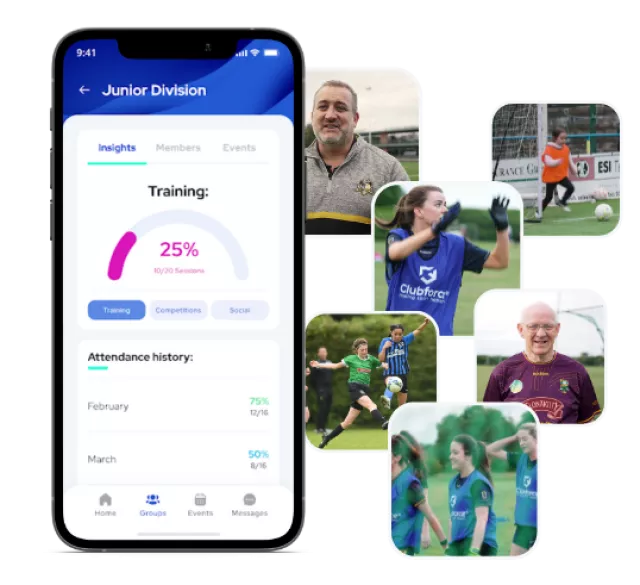
With constant social media, activities, marketing, we live in a world of distraction. It’s less likely for a child to be signed up for one local sports club and remain a member of that club – and that club alone – all the way into adulthood. It’s important for clubs to think about a minimum number of members that they require to keep the club functioning even when interest levels drop – if that does happen, eventually they will return, and it’s important the club is there to serve the need when they do.
Why do members drop off mid-season?
Many clubs tend to see this common trend, where levels of interest peak and dip as the season progresses – this may be down to on-field success, changing interests as kids get older and the challenges associated with study and education as teenagers approach exam years. Like candy in a shop, there are countless options available when it comes to choosing a type of sport to participate in at an individual and team level, so it’s easy for the eyes to wander until they stumble on a favourite. Simply, it could be that the parents experience stressors relating to the financial and time investment that youth sport requires.
Additionally, there are other time-consuming activities that compete with sports clubs such as video games, learning to play a musical instrument and other distractions which make it harder for sports clubs to attract and retain members.
So, this begs the question in this increasingly competitive environment – how does a sports club stand out from the crowd for long-term success?
Here are five tips on how to grow your sports club.
1. Create A Sense of Community
Well-run clubs understand what it means to build a positive ‘sense of community‘ – what exactly does that mean? Does it happen accidentally or is it a deliberate effort? Perhaps it’s a bit of both but clubs that want to grow should spend some time thinking about what it entails.
People want to belong to something and experience the reward and recognition of being part of a successful community. You often hear the words ‘steeped in’ in reference to a member or family’s contribution to a sports club – this is a long-standing emotional connection, a shared history between club members that has developed over generations. Whether by accident or by design, that sense of community is vital to ensuring clubs prosper in the long-term.
2. Set A Benchmark & Targets
If your aim is to grow your club, you will need to grow club revenue. One feeds the other in many respects as a well-resourced club can provide the amenities to attract new members but more members also leads to more revenue. Either way, knowing your current status is your starting point – can you easily report on club member numbers? Do you know if your clubs membership and revenue is trending upwards or downwards?
Setting a benchmark of your current level and agreeing an achievable set of targets at an AGM is a great way of energising members and encouraging wider participation in the sports club. This can be routinely monitored in club performance reports, seeing if the club is progressing as intended.
3. Be Seen & Heard
How is the broader community kept up-to-date with your club’s progress? Do they know volunteer numbers are down? Do they know your Treasurer is planning to retire? Do they know there’s an Open Day taking place ahead of the new season? How are they kept abreast of developments (big and small) in your club?
How you communicate with the wider community is vital to sustaining a successfully run club. If it’s easy for club members to register online, or if you have an upcoming club fundraiser for a capital project – how do you get the message across? Using available channels – online and offline – to make people aware of your club and what is going on each week is a great way of making people aware of your club’s progress and the gaps that need to be filled to help make the club more successful.
Local businesses will realise that a successful sports club in a town or village can have a knock-on effect for their business and are likely to support communication efforts whether that be a poster in the butcher’s window or sharing something from the club on their business website or Facebook page. Who coordinates this effort and makes it all happen… that leads us on to volunteers.
4. Build A Strong Volunteer Base
The club volunteer is one of the most underappreciated roles in most social spheres. But good volunteers are vital to the success of sports clubs at a local level, which in turn feeds the success of the sport at a national (and perhaps international) level.
If a club is to be a something that people want to be a part of it has to be well resourced – as well as administrative volunteers, coaches, social media contributors and first aid personnel who can spare their time play a vital part in ensuring that a club is well run. Both the GAA and IRFU give excellent guidance on recruiting, managing and retaining volunteers – a key point to take away from these guides is to spread the volunteering workload – make it easier for people to say ‘yes’ to volunteering instead of a small number of people being required to do all tasks in a limited time-frame. It’s also worth emphasising the many benefits of volunteering at the club to these potential volunteers as the people you ask may have different motivations depending on their age, family status etc.
Volunteers should also receive some recognition for their efforts – this can be done informally or formally – end of year awards campaigns often tend to focus on on-field performances (as they should) but a ‘Volunteer of the Year‘ award is a fitting way to recognise the efforts of someone who has gone the extra mile to ensure the success of the club over the year. Being ‘steeped in’ a sports club has to start somewhere and it doesn’t always have to be performances on the field that create a lifelong association with a club.
5. Do Something Different
How does your club differentiate itself from the other sports clubs in your area – or non-sporting options for that matter? Other than the shape of the ball, what can your club offer that no other club can match? The headings above can each contribute towards something unique about your club that children, parents and other members should consider – but perhaps there is more you can be doing to make your club the most attractive prospect in town. Think about what you can do to ensure it’s easy to join and participate in your club – maybe it’s the facilities, the volunteer effort. Asking members for feedback on what they would like to see done differently and encouraging participation from diverse elements of the member base can also make the club more appealing.
Is your club growing or shrinking?
Many clubs find it difficult to measure progress in terms of membership growth without adequate tools to do so. Club membership numbers may seem to plateau or even drop-off and this may be explained by more members leaving the club than new members joining. However that’s not usually the case – digging into membership reports can provide valuable insight into how the club membership is really developing.
With the Clubforce, clubs can easily see which members are coming to training and where the drop-offs are occurring. With this information the club can identify trends in where drop-offs occur and make changes to how they recruit and retain members. Retaining existing members is important to have a strong base to grow from.

If your club needs help retaining members and growing the club’s membership, fill in this form and let us show you how Clubforce can help!





